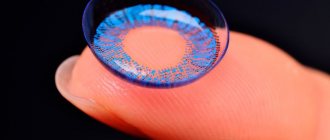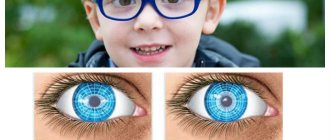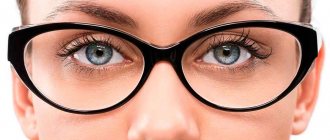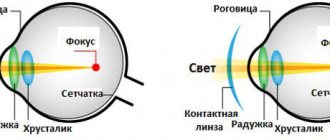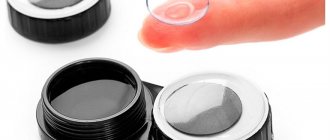Aspherical contact lenses or contact lenses with an aspherical surface design, however, like spectacle lenses with an aspherical design, have recently become increasingly popular.
In this article we will try to understand what aspheric and spherical design of contact lenses are, what are the advantages of an aspheric design over a spherical one when correcting eye vision, and whether it is necessary to get used to aspheric lenses.
The quality of vision is characterized by such concepts as visual acuity, clarity, and image contrast.
Normal visual acuity is one or 100%.
Why is it that sometimes with 100% vision correction there are complaints about insufficient image clarity?
The main reason is the presence of optical aberrations. Aberration is the deviation or distortion of light rays passing through optical media due to the imperfection of these media. There are aberrations both in the human eye, since the eye is an optical system consisting of optical media (cornea, lens) that are not always ideal, and in corrective lenses, both spectacle and contact lenses.
There are two types of aberrations:
- Lower order aberrations
- Aberrations of the highest order
Description
Before moving on to the description of such lenses, you need to understand how they differ from spherical products.
Traditional glasses have a spherical lens surface. That is, the lens is part of the sphere of the ball. The radius of its curvature is the same over the entire surface.
The aspherical lens has a sophisticated design. The radius of its curvature varies from the central part to the periphery. At the same time, the glass becomes thinner and flatter. Due to the fact that it does not have distortions at the edges (abberrations) characteristic of spherical lenses, the field of view of an aspherical product is much wider.
Due to the complexity of manufacturing such lenses, they are more expensive than spherical ones. In addition, they have their own expiration date. But even these shortcomings cannot diminish all the advantages of such glasses.
What are aspherical glasses
This product is considered innovative in modern ophthalmology. Some differences from ordinary spherical glasses have already been described, but that's not all.
It is also worth considering the question of what effect aspherical products have on the indicator of visual ability:
- When wearing spherical lenses in glasses, a clear image is guaranteed only when visible through their center;
- Aspherical glasses make it possible to see surrounding objects equally well from different viewing angles. There is no visual strain as with conventional lenses.
History of creation
For the first time, lenses for aspherical glasses appeared in the last century in the 50s. They were originally intended for patients with cataracts whose eye lens had been removed. Such patients required a correction of 12-17 diopters, and it was extremely difficult to provide it with heavy spherical lenses.
The problem was solved after using aspherical glasses on the glasses. With their help, vision was perfectly corrected, plus they were thinner and lighter in weight.
Expert opinion
Kim Oksana Alexandrovna
Head of the ophthalmology clinic. Ophthalmologist with more than 10 years of experience.
Nowadays, patients with a removed lens are fitted with intraocular lenses. Aspheric glasses are used for abnormal refractions associated with myopia, astigmatism, farsightedness, and presbyopia.
Rodenstock became a mass producer of aspherical lenses for the first time. Its first lens, Cosmolit, appeared on the sales market in 1991. Its optical power was +10 diopters. Later, other companies began to produce AL. Today they are produced by many brands, including:
- Seiko (Japanese company);
- Rodenstock (Germany);
- Essilor (French manufacturer);
- Nikon (Japan);
- See World Optical (South Korea), etc.
Aspheric optics are also used in the manufacture of camera lenses, which makes the image clearer and of higher quality. So, Canon first began to use such lenses back in 1971. But due to the complexity of lens manufacturing, aspherical glass is used only in professional lenses.
Advantages of aspherical lenses
- Intraocular lenses with advanced optics have aspherical front and rear surfaces, which eliminates spherical aberrations and minimizes optical anomalies;
- The acuity and quality of vision with such lenses do not change when the optical axis of the eye or the center of the pupil is shifted;
- Anti-Glare technology protects against unwanted optical anomalies and glare from bright light sources;
- Aspheric IOLs have a continuous square edge and in most cases prevent the development of secondary cataracts.
Compare the quality of vision obtained with an implanted IOL with an aspheric optic. Select lighting conditions and move the lens across the picture.
Daylight Twilight Nightlight
Who are eyepieces recommended for?
Ophthalmologists are increasingly prescribing aspherical lenses to their patients. And all because their optical properties are much superior to conventional ones, and also contribute to the most comfortable wearing.
Due to the thin glass and lightness of the products, any, even the most prolonged visual stress, does not strain the eyes so much.
Doctors prescribe such glasses in the following cases:
- For long and regular car trips.
- With age-related changes in the visual organ (eye presbyopia).
- With a high degree of myopia.
- With such a deficiency as farsightedness (another name for hypermetropia).
- When the above diseases are combined with astigmatism.
The complex geometry of aspherical glass compared to spherical glass makes the lens profile more refined while maintaining optical features. Even high diopters do not interfere with the aesthetic and attractive properties of such glasses.
A fly in the ointment, or the disadvantages of complex optics
Some users of aspherical lenses for glasses have noted reflections of light on them, glare. This is explained by the fact that they are thinner and located close to the eyes. To avoid such effects, it is recommended to apply an anti-reflective coating to them.
The cost of such optics is higher than the cost of spherical optics, since due to its complex geometry its production is more labor-intensive. But its advantages pay off with interest. This includes high quality vision, comfort in wearing glasses and external aesthetics.
There are cases that some users have spherical aberrations that differ from the average value for which aspherical optics are designed. In such cases, wearing it instead of improving vision can lead to its deterioration. Therefore, in each specific case its effect must be tested in practice.
Which glasses to choose: with aspherical or spherical lenses
When answering this question, it is best to first consult an ophthalmologist. He will be able to study your problem and prescribe the necessary glasses. Moreover, aspheric lenses may also have contraindications, for example, with previously poor adaptation to wearing corrective glasses. But so that you can understand the main differences between spherical and aspherical devices for glasses, it is worth giving a table of the features of these two types of glasses.
Comparison of spherical and aspherical lenses
Comparative characteristics of the two types of glasses are presented in the table. It is worth noting that when choosing suitable lenses you need to pay attention to the inscriptions. Aspherical will be designated by the combination of letters AS. To produce such glasses, the presence of the client is necessary, since they are made based on the individual characteristics of the person and his vision.
| Main differences | Spherical lenses | Aspherical lenses |
| Design features | The radius of curvature is the same throughout the lens, with constant optical power and convexity. | The convexity and optical power of the glasses changes from the central part to the peripheral part. |
| Lens shape and thickness | The glass is thick with a convex central part or thickened edges. | The glass is thinner and flatter, easily inserted into any frame. |
| External data | Such lenses protrude from the frame and look sloppy. This is especially true for spherical lenses with high optical power. | Even with significant diopters, they remain thin. People with nearsightedness and farsightedness can wear such glasses without any problems. |
| Aesthetics | With plus lenses, the illusion of large eyes is created, with minus lenses, on the contrary, the eyes visually become smaller. As a result, facial features change proportions and become distorted. | Even with high optical power of the lenses, facial features are not distorted. This is achieved due to the thinness of the lenses, which look good in any frame or without one at all. The eyes look natural without changing their shape. |
| Optical features | Areas of light scattering remain on the retina, which distorts visual images. Spherical aberrations (visual distortions) are present. | Visual aberrations do not occur. Lateral vision remains virtually unchanged, and the field of view does not narrow. That is, glass maximizes the space in lateral vision. |
| Manufacturing technique | The glasses are easy to make and therefore inexpensive. | Such lenses undergo complex production, and accordingly their price will be higher. |
| Manufacturing Features | The surface of the lenses is formed by rotating a part of the circle around the axis of symmetry. | Rotation around the axis of a parabola, hyperbola or ellipse. Sometimes the aspheric zone begins at the edge, sometimes in the center. |
Knowing the main differences between spherical and aspherical lenses, you can decide for yourself which one is better to purchase. However, consultation with an ophthalmologist is still necessary, since everything is individual.
Currently, optometrists are opening offices of ophthalmologists, where you can check your vision on the spot, get competent advice and purchase glasses, which will also be selected for you by professionals.
What is spherical aberration?
Spherical aberrations (image distortions) arise due to the refraction of light at different angles as it passes through the spherical surface of the intraocular lens and the optical media of the eye. Without proper correction, light rays are not focused accurately on the retina and the image may become distorted.
Spherical optics produce an imperfect image because the optical power is unevenly distributed.
An aspherical lens has the same optical power in all areas, resulting in a higher quality image.
Green lenses for brown eyes - what to look for?
- In real life, on brown eyes, the optics will look a little different than in the picture. This is due to the fact that models who are photographed wearing lenses have eyes that have a completely different tone and iris pattern. Therefore, when trying on the same product on different people, it will look different.
- The central zone of the lens remains transparent - it is a small circle, the diameter of which varies from manufacturer to manufacturer. Therefore, when the pupil contracts in bright light (for example, in the sun during the day), its shade will be slightly visible.
- Colored lenses are the same medical products as clear ones. Therefore, along with a new pair of optics, you need to purchase a solution for cleaning and storage, a container and enzyme cleaners to remove protein deposits (for products with a replacement period of more than a month).
- The colored layer does not affect the cornea in any way, since it is “sealed” inside the product. In addition, it is not washed off when using solutions and enzyme tablets, maintaining the brightness of the color and saturation of the pattern until the last day of use.
Green contact lenses are the ideal choice for brown eyes
Green lenses are most suitable for brown eyes. Such ophthalmic products harmonize well with the natural shade of skin, hair, eyelashes and eyebrows, without straying from the general color scheme. In this case, you can achieve different effects: for a more natural look, choose lenses in a grassy, dark green or olive color, and for a brighter and more unusual look, choose an emerald shade.
Nowadays, it is quite easy to find decoratively colored lenses for light and dark brown eyes. For this, colored rather than tint models are more suitable. The thing is that the colored layer of colored lenses is opaque, so it completely covers the iris and makes it possible to “hide” even the dark shade of the eyes. Plus, manufacturers apply a pattern to the surface that is as close as possible to the pattern of the iris.
